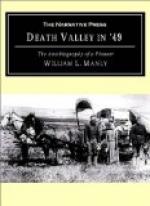To the northwest we could see a clay lake, or at least that was what we called it, and a line of low hills seemed to be an extension of the mountain in a direction swinging around to the south to enclose this thirsty, barren plain before us, which was bounded by mountains or hills on these sides. To the south this range seemed to get higher, and we could see some snow capped mountains to the south of our westerly course. The low mountains as those seen in the northwest direction is the same place now crossed by the Southern Pacific Railroad, and known as the Tehachipi pass, the noted loop, in which the railroad crosses itself, being on the west slope and Ft. Tejon being on the same range a little further south where the Sierra Nevada mountains and the Coast Range join. The first mountain bearing snow, south of our course was probably what is known as Wilson’s peak, and the high mountains still farther south, the San Bernardino mountains. There were no names there known to us nor did we know anything of the topography of the country except that we supposed a range of mountains was all that separated us from California.
We were yet in the desert, and if we kept our due west course, we must cross some of the snow before us which if steep gave us some doubts whether we could get through or not.
We did not know exactly what the people left behind would do if we were gone longer than we intended, but if they started on it was quite plain to us they would be lost, and as seven days had already passed we were in serious trouble for fear we could not complete the trip in the time allotted to us. We surveyed the plain and mountains to learn its situation and then started, on following our trail. As we went on we seemed to be coming to lower ground, and near our road stood a tree of a kind we had not seen before. The trunk was about six or eight inches through and six or eight feet high with arms at the top quite as large as the body, and at the end of the arms a bunch of long, stiff bayonet shaped leaves.
It was a brave little tree to live in such a barren country. As we walked on these trees were more plenty and some were much larger than the first. As we came to the lowest part of the valley there seemed to be little faint water ways running around little clouds of stunted shrubs, but there was no signs that very much water ever run in them. We thought that these were the outlet of the big sandy lake which might get full of water and overflow through these channels after some great storm.
As this low ground was quite wide we lost our trail in crossing it, and we separated as we went along, looking to find it again, till nearly dark when we looked for a camping place. Fortunately we found a little pond of rain water, and some of our strange trees that were dead gave us good material for a fire, so that we were very comfortable indeed, having both drink and fire.




